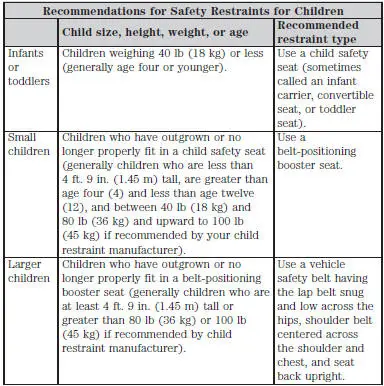Ford Mustang (2005-2014) Owners Manual: Child Safety
GENERAL INFORMATION
See the following sections for directions on how to properly use safety restraints for children.
WARNING: Always make sure your child is secured properly in a device that is appropriate for their height, age and weight.
Child safety restraints must be bought separately from your vehicle.
Failure to follow these instructions and guidelines may result in an increased risk of serious injury or death to your child.
WARNING: All children are shaped differently. The recommendations for safety restraints are based on probable child height, age and weight thresholds from NHTSA and other safety organizations, or are the minimum requirements of law. Ford recommends checking with a NHTSA Certified Child Passenger Safety Technician (CPST) and consulting your pediatrician to make sure your child seat is appropriate for your child, and is compatible with and properly installed in your vehicle. To locate a child seat fitting station and CPST, contact the NHTSA toll free at 1-888-327-4236 or on the internet at http://www.nhtsa.dot.gov. In Canada, check with your local St. John Ambulance office for referral to a CPST or for further information, contact your provincial ministry of transportation, or locate your local St. John Ambulance office by searching for St. John Ambulance on the internet, or Transport Canada at 1–800–333–0371 (http://www.tc.gc.ca).
Failure to properly restrain children in safety seats made especially for their height, age, and weight may result in an increased risk of serious injury or death to your child.

• You are required by law to properly use safety seats for infants and
toddlers in the United States and Canada.
• Many states and provinces require that small children use approved
booster seats until they reach age eight, a height of 4 feet 9 inches
(1.45 meters) tall, or 80 pounds (36 kilograms). Check your local and
state or provincial laws for specific requirements about the safety of
children in your vehicle.
• When possible, always properly restrain children twelve (12) years of
age and under in a rear seating position of your vehicle. Accident
statistics suggest that children are safer when properly restrained in
the rear seating positions than in a front seating position. See Front
Passenger Sensing System in the Supplementary Restraints System
chapter for more information.
 Introduction
Introduction
ABOUT THIS MANUAL
Thank you for choosing Ford. We recommend that you take some time
to get to know your vehicle by reading this manual. The more that you
know about it, the greater the safety and plea ...
 Child seat positioning
Child seat positioning
WARNING: Airbags can kill or injure a child in a child seat.
Never place a rear-facing child seat in front of an active airbag.
If you must use a forward-facing child seat in the front seat, move th ...
Other materials:
Disassembly
Initial disassembly
1. Remove the differential housing cover (4033) and drain the lubricant into
a suitable container.
2. Wipe the lubricant from the internal working parts and inspect the parts for
wear and damage.
3. Using the special tool, measure and n ...
Engine Mount
Special Tool(s)
Support Bracket, Engine
303-639
3-Bar Engine Support Kit
303-F072
Alignment Tool, Subframe
502-004
...
Rear Drive Axle/Differential - Ford 8.8-Inch IRS
General Specifications
Torque Specifications
a: Use Stud and Bearing Mount EOAZ-19554-BA or equivalent meeting Ford
specification WSKM2G349-
A1.
b: With pinion flange yoke seal. ...
